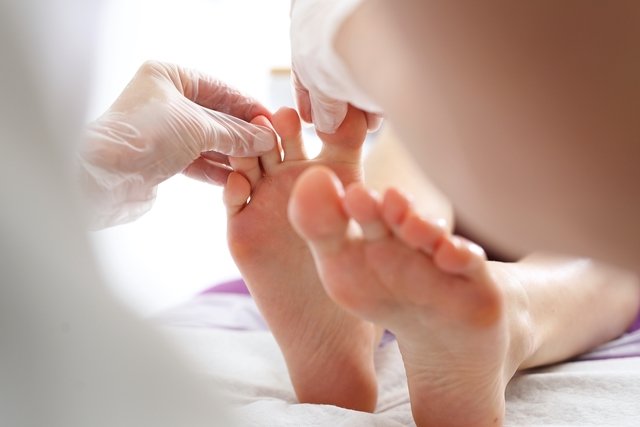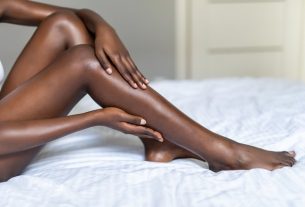Tinea pedis, also known as athlete’s foot, chilblains, ringworm or foot ringworm, is a fungal skin infection that affects the feet and usually starts between the toes, causing itching, redness, flaking and a bad smell, for example .
This type of mycosis is mainly caused by fungi of the genus Trichophyton sp.which can be found in the outer layers of the skin and be transmitted through skin contact with contaminated floors, towels or clothing, or proliferate when the area between the fingers is moist, for example.
The treatment of Tinea pedis must be recommended by the dermatologist, who normally recommends the use of antifungal ointments or creams that must be applied to the site of symptoms, and it is important that the treatment is carried out in accordance with medical advice to prevent the fungus from returning. to grow and cause symptoms again.

Main symptoms
Symptoms of Tinea pedis appear when the fungus proliferates on the skin of the feet, and can affect the region between the toes, the sole or the side of one or both feet, and include:
- Itching or burning sensation between the fingers or soles of the feet;
- Redness of the affected area;
- Blisters on the feet that itch;
- Cracked or peeling skin, most common between the toes and soles of the feet;
- Dry skin on the soles or sides of the feet;
- Stinky feet.
In more serious cases, due to the multiplication of the fungus, the nail may be compromised, giving rise to onychomycosis, a condition in which the toenails may become discolored, thick, crumbly and detached from the skin. Understand better what onychomycosis is and how to treat it.
How to confirm the diagnosis
The diagnosis of Tinea pedis is made by the dermatologist by evaluating the symptoms presented by the person.
To assess your risk of Tinea pedis, make an appointment with the dermatologist in the area closest to you:
Taking care of your health has never been easier!
To confirm Tinea pedis and the fungus responsible, the doctor can scrape the lesion, which consists of removing some skin cells and analyzing them under a microscope with the aim of identifying the fungus and, thus, starting the most appropriate treatment.
Possible causes
Tinea pedis can be caused by fungi of the species Trichophyton rubrum, Trichophyton interdigitale or Epidermophyton floccosumwhich grow in hot and humid environments and, therefore, when the area between the fingers is not dried correctly, for example, it is possible for these fungi to proliferate and lead to the appearance of symptoms.
These fungi can be transmitted through contact with scales on the skin of an infected person or contact with surfaces contaminated with the fungi such as showers, bathtubs, changing room floors or around swimming pools, for example.
Furthermore, some factors may contribute to the development of Tinea pedis, and include:
- Keep your feet wet or sweating for a long time;
- Do not dry well feet after bathing;
- Do not wear flip-flops or other footwear when visiting public places, especially changing rooms, showers, saunas and swimming pools;
- Share socksshoes, bedding, rugs, mat or towels with an infected person;
- Wear closed shoes or tight for too long.
Furthermore, living in very hot and humid regions, participating in sports where you are barefoot on the mat, such as wrestling, or having a weakened immune system, for example, can increase the risk of developing Tinea pedis.
How the treatment is carried out
Tinea pedis treatment needs to be guided by a dermatologist and usually includes remedies such as:
- Antifungals in ointment formgel, cream, powder or spray, such as terbinafine, ketoconazole, clotrimazole or miconazole, applied directly to the skin in the affected region, generally 1 to 2 times a day, for 15 to 30 days of treatment;
- Antifungals in tablet formsuch as griseofulvin, terbinafine or itraconazole, taken orally, in cases of severe Tinea pedis or those that do not improve with topical treatment.
The treatment time must be indicated by the dermatologist, according to the symptoms, type of fungus, severity of the mycosis and the person’s health status, and it is important that it is carried out according to the doctor’s instructions to ensure the elimination of the fungus.
Home Treatment Options
Some home treatment options for Tinea pedis are rosemary tea, lemongrass tea or tea tree essential oil, which can be used to complement medical treatment and speed up recovery. These remedies have antifungal, anti-inflammatory or healing effects, relieving itchy skin naturally.
Home remedies can be prepared at home with natural ingredients purchased from pharmacies or health food stores, and used directly on the skin of the feet. Learn how to prepare home remedies for Tinea pedis.
How to prevent
Some precautions are important to prevent or reduce the risk of infection by the fungi that cause Tinea pedis, such as:
- Dry well between your fingers after showering and, if possible, let your feet air out as much as possible before putting on shoes;
- Change socks every time you put on shoes, and whenever they are damp;
- Wear light shoes and ventilated whenever possible;
- Avoid synthetic shoessuch as vinyl or rubber;
- Avoid wearing closed shoes without wearing cotton socks;
- Don’t wear the same pair of shoes every day, to give the shoe time to dry well after use;
- Wear flip flops or sandals in public places;
- Don’t share socksshoes or personal objects with other people;
- Wash your skin well with neutral soap after sports that involve being barefoot.
Furthermore, if you have someone close to you with Tinea pedis, it is important to ensure that the person is treated to prevent transmission of the fungus.

Sign up for our newsletter and stay up to date with exclusive news
that can transform your routine!
Warning: Undefined array key "title" in /home/storelat/public_html/wp-content/plugins/link-whisper-premium/templates/frontend/related-posts.php on line 12
Warning: Undefined array key "title_tag" in /home/storelat/public_html/wp-content/plugins/link-whisper-premium/templates/frontend/related-posts.php on line 13



